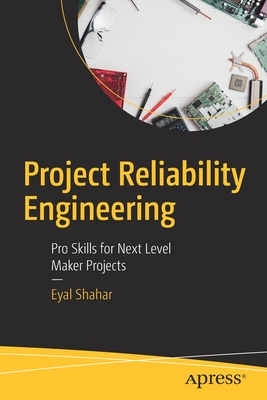Project Reliability Engineering: Pro Skills for Next Level Maker Projects
暫譯: 專案可靠性工程:進階製作專案的專業技能
Shahar, Eyal
- 出版商: Apress
- 出版日期: 2019-09-29
- 售價: $1,730
- 貴賓價: 9.5 折 $1,644
- 語言: 英文
- 頁數: 290
- 裝訂: Quality Paper - also called trade paper
- ISBN: 1484250184
- ISBN-13: 9781484250181
-
相關分類:
Raspberry Pi
海外代購書籍(需單獨結帳)
相關主題
商品描述
Most examples use the Raspberry Pi, but the techniques discussed apply to other platforms as well. This book is all about breadth, and in the spirit of making, it visits different technologies as needed. However, the big goal in this book is to create a shift in the reader's mindset, where weekend hacks are pushed to the next level and are treated as products to be deployed. In that regard, this book can be a stepping stone for hobbyist makers into developing a broader, professional skill set.
First, the book describes techniques for creating web-browser based dashboards for projects. These allow project creators to monitor, control, and troubleshoot their projects in real-time. Project Reliability Engineering discusses various aspects of the process of creating a web dashboard, such as network communication protocols, multithreading, and web design, and data visualization.
Later chapters cover configuration of the project and the machine it's running on, and additional techniques for project monitoring and diagnosis. These include good logging practices; automatic log and metrics monitoring; and alerting via email and text messages;
A mixture of advanced concepts forms the last chapter of the book, touching on topics such as usage of microservices in complex projects; debugging techniques for object-oriented projects; and fail-safing the project's software and hardware.
What You'll Learn
- Monitor and control projects, keep them up and running, and troubleshoot them efficiently
- Get acquainted with available tools and libraries, and learn how to make your own tools
- Expand your knowledge in Python, JavaScript and Linux
- Develop deeper understanding of web technologies
- Design robust and complex systems
Who This Book Is For
Members of the maker community with some development skills.
商品描述(中文翻譯)
將您的專案從週末的隨意創作轉變為長期的創作
本書從大型軟體公司所稱的網站可靠性工程(Site Reliability Engineering, SRE)領域中獲取靈感,提煉出這些學科的精華,並針對創作者所關心的議題進行探討:保持專案的運行,並提供控制、監控和故障排除的手段。
大多數範例使用 Raspberry Pi,但所討論的技術同樣適用於其他平台。本書的重點在於廣度,並在創作的精神下,根據需要探討不同的技術。然而,本書的主要目標是改變讀者的思維方式,將週末的隨意創作提升到一個新的層次,並將其視為可部署的產品。在這方面,本書可以成為愛好者創作者進入更廣泛、專業技能組合的踏腳石。
首先,本書描述了為專案創建基於網頁瀏覽器的儀表板的技術。這些儀表板允許專案創建者實時監控、控制和故障排除他們的專案。《專案可靠性工程》(Project Reliability Engineering)討論了創建網頁儀表板過程中的各個方面,例如網路通信協議、多執行緒、網頁設計和數據可視化。
後面的章節涵蓋了專案及其運行機器的配置,以及專案監控和診斷的其他技術。這些包括良好的日誌記錄實踐、自動日誌和指標監控,以及通過電子郵件和簡訊發送警報。
本書的最後一章涵蓋了一系列進階概念,涉及複雜專案中微服務的使用、面向物件專案的除錯技術,以及專案軟體和硬體的故障安全設計。
您將學到的內容
- 監控和控制專案,保持其運行,並有效地進行故障排除
- 熟悉可用的工具和函式庫,並學習如何製作自己的工具
- 擴展您在 Python、JavaScript 和 Linux 的知識
- 深入理解網頁技術
- 設計穩健且複雜的系統
本書適合對象
具備一定開發技能的創作者社群成員。
作者簡介
The exhibits Eyal makes are strange hybrids: like a maker's project, they are usually one-offs, often consisting of patches of software written in haste, skipping over industry standards such as passing unit-tests and following design documents. On the other hand, because they live on a museum floor, they must be rock solid. As he developed techniques to monitor and stabilize his exhibits, Eyal realized he was also applying these methods on his personal projects. Eyal is excited at the prospect of making these available to the rest of the maker community.
作者簡介(中文翻譯)
Eyal Shahar 目前居住在舊金山,擔任 Exploratorium 新媒體部門的展覽開發者。Eyal 的職業生涯始於專業音樂家,與以色列一些最知名的藝術家合作超過十年。他在音樂和藝術相關的初創公司中擁有軟體和硬體工程的經驗,這些公司位於特拉維夫、巴黎和舊金山。Eyal 擁有特拉維夫大學的電機工程學士學位,以及麻省理工學院媒體實驗室的媒體、藝術與科學碩士學位。
Eyal 所製作的展覽是奇特的混合體:就像創客的專案一樣,這些展覽通常是一次性的,經常包含匆忙編寫的軟體片段,跳過了行業標準,例如單元測試和設計文件的遵循。另一方面,因為它們位於博物館的展覽區,所以必須非常穩固。在他開發監控和穩定展覽的技術時,Eyal 意識到他也在將這些方法應用於自己的個人專案。Eyal 對於將這些技術提供給其他創客社群的前景感到興奮。












